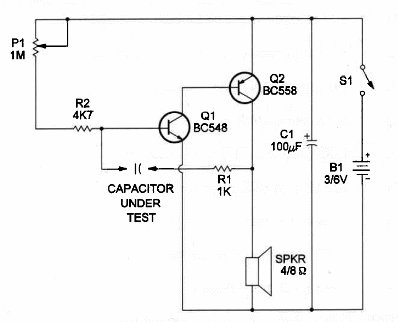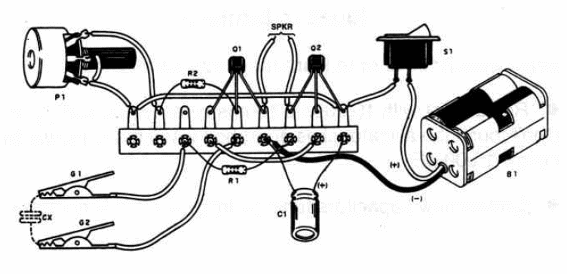This circuit can be used to test metal film ceramic capacitors and other types of capacitors in a range of values between 470 pF to 10 µF.
The device is formed by an audio-oscillator that produces a tone determined by the capacitor under test.
Probes connect the capacitor to the circuit. The frequency of the produced tone is higher for lower-value capacitors.
A falling tone indicates a bad capacitor.
Testing capacitors in the range between 1 and 10 µF, the oscillator will produce separated audio pulses, working like a metronome.
The circuit is powered by two or four AA cells, and current drain is very low.
P1 is adjusted to set an audible tone at the speaker, according the value of the capacitor being tested.
You can also use this device to compare capacitor values.
Two capacitors with the same value will give the same tone.
The schematic diagram of the Capacitor Tester is shown in Figure 1.

The circuit has as its heart two complementary transistors working as a direct coupled amplifier.
Feedback is provided by resistor R1 and the capacitor under test.
Components placement on a terminal strip is shown in Figure 2.

Use this parts placement as a guide when assembling the terminal strip and when housing the circuit into a box.
Termination components should be short as possible to avoid instability.
Position of the polarized components, such as the electrolytic capacitor and power supply, should be observed when mounting.
The capacitor under test is placed in the circuit by two alligator clips as shown in Figure 2.
The circuit can be housed in a small plastic box.
Capacitor Tester
Q1 - BC548 general-purpose NPN transistor
Q2 - BC558 general-purpose PNP transistor
R1 - 1,000 ohm, ¼ W, 5% resistor
R2 - 4,700 ohm, ¼ W, 5% resistor
P1 - 1,000,000 ohm, ¼ W, 5% resistor
C1 - 100 µF, 6 WVDC electrolytic capacitor
Cx - capacitor in test
S1 - SPST toggle or slide switch
B1 - 3 or 6V - 2 or 4 AA-cells
SPKR - 4 to 8 Ω - 2 to 4 in. loudspeaker
Ideas to Explore
To get better performance or to learn more about the circuit:
Replace P1 with 10,000,000 Ω to test capacitors under 470 pF. Don’t touch the alligator clips or probes when testing small capacitors bellow 1,000 pF.
Explain how capacitors function in this circuit. What is feedback?
Science projects and uncommon uses:
Mount an experimental capacitor using aluminum foil and paper as dielectric. Test the capacitor using this device and compare the value with known capacitors.
Experiments involving capacitive transducers can be conducted with this circuit. The circuit can be used as an analog-to-digital (ND) converter. These circuits can convert capacitances (an analog quantity) into frequencies (a digital quantity). With an appropriate conversion scale it will be possible to use alfrequency counter to measure capacitances.




